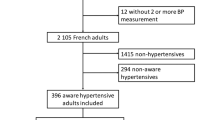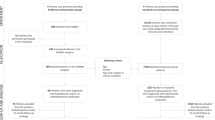Abstract
Identifying barriers to hypertension management may facilitate cardiovascular risk reduction. Therefore, our objective, was to determine the prevalence of hypertension not managed with medication (‘untreated’) in a representative adult sample and identify patient factors/beliefs, and aspects of the patient–general practitioner (GP) relationship associated with untreated hypertension. The North West Adelaide Health Study, a biomedical cohort study over three stages from 2000–2009, assesses hypertension (systolic⩾140 mm Hg and/or⩾90 mm Hg or current treatment with anti-hypertensive medication), chronic disease and associated risk factors and health-care experiences, including risk perception, decision-making preferences, GP/primary care provider affiliation and satisfaction with care (n=2425). The prevalence of hypertension was 32.1% (n=781) comprised of treated (19.0%, n=462) and untreated (13.1%, n=319) hypertension. Thus, 40.8% of hypertension was untreated. Among hypertensive subjects, non-treatment was significantly associated with male sex, age <45 years, workforce participation, infrequent GP visits, dissatisfaction with recent medical care, high total cholesterol, moderate-level physical activity and lower body weights. Compared with participants without hypertension (and no treatment), untreated subjects demonstrated significant (15%) 10-year Framingham general cardiovascular risk (odds ratio=6.44, 95% confidence interval=4.52–9.17). Novel screening strategies and public health messages to address beliefs and perceptions of both patients and the health system are required to identify untreated, at-risk hypertensive individuals.
This is a preview of subscription content, access via your institution
Access options
Subscribe to this journal
Receive 12 digital issues and online access to articles
$119.00 per year
only $9.92 per issue
Buy this article
- Purchase on Springer Link
- Instant access to full article PDF
Prices may be subject to local taxes which are calculated during checkout
Similar content being viewed by others
References
Egan BM, Zhao YM, Axon RN . US trends in prevalence, awareness, treatment, and control of hypertension, 1988-2008. JAMA 2010; 303 (20): 2043–2050.
McAlister FA, Wilkins K, Joffres M, Leenen FHH, Fodor G, Gee M et al. Changes in the rates of awareness, treatment and control of hypertension in Canada over the past two decades. Can Med Assoc J 2011; 183 (9): 1007–1013.
Wolf-Maier K, Cooper RS, Banegas JR, Giampaoli S, Hense H-W, Joffres M et al. Hypertension prevalence and blood pressure levels in 6 European countries, Canada, and the United States. JAMA 2003; 289 (18): 2363–2369.
McRae I, Yen L, Gillespie J, Douglas K . Patient affiliation with GPs in Australia--Who is and who is not and does it matter? Health Policy 2011; 103 (1): 16–23.
Britt H, Miller G, Charles J, Knox S, Valenti L, Henderson J et al General practice activity in Australia 2004-05. AIHW: Canberra, 2005.
Howes F, Hansen E, Williams D, Nelson M . Barriers to diagnosing and managing hypertension. A qualitative study in Australian general practice. Aust Fam Physician 2010; 39 (7): 511–516.
National Heart Foundation of Australia (National Blood Pressure and Vascular Disease Advisory Committee). Guide to Management of Hypertension 2008, Updated 2010.
Jackson R, Lawes CMM, Bennett DA, Milne RJ, Rodgers A . Treatment with drugs to lower blood pressure and blood cholesterol based on an individual's absolute cardiovascular risk. Lancet 2005; 365 (9457): 434–441.
Carrington MJ, Jennings GL, Stewart S . Pattern of blood pressure in Australian adults: results from a National Blood Pressure Screening Day of 13,825 adults. Int J Cardiol 2010; 145 (3): 461–467.
Webster RJ, Heeley EL, Peiris DP, Bayram C, Cass A, Patel AA . Gaps in cardiovascular disease risk management in Australian general practice. Med J Australia 2009; 191 (6): 324–329.
Chua B, Rochtchina E, Mitchell P . Temporal changes in the control of blood pressure in an older Australian population. J Hum Hypertens 2005; 19 (9): 691–696.
Briganti EM, Shaw JE, Chadban SJ, Zimmet PZ, Welborn TA, McNeil JJ et al. Untreated hypertension among Australian adults: the 1999-2000 Australian Diabetes, Obesity and Lifestyle Study (AusDiab). Med J Australia 2003; 179 (3): 135–139.
O'Riordan S, Mackson J, Weekes L . Self-reported prescribing for hypertension in general practice. J Clin Pharm Ther 2008; 33 (5): 483–488.
Heeley EL, Peiris DP, Patel AA, Cass A, Weekes A, Morgan C et al. Cardiovascular risk perception and evidence-practice gaps in Australian general practice (the AusHEART study). Med J Australia 2010; 192 (5): 254–259.
Grant JF, Taylor AW, Ruffin RE, Wilson DH, Phillips PJ, Adams RJ et al. Cohort profile: the North West Adelaide Health Study (NWAHS). Int J Epidemiol 2008; 38: 1479–1486.
Taylor A, Wilson D, Wakefield M . Differences in health estimates using telephones and door-to-door survey methods- a hypothetical exercise. Aust NZJ Public Health 1998; 22: 223–226.
Clark R . Australian Patient Safety Survey. Health Issues 2001; 69: 20–24.
National Patient Safety Foundation at the AMA [American Medical Association]. Public Opinion of Patient Safety Issues: Research Findings. National Patient Safety Foundation: Boston, 1997.
Radloff L . The CES-D scale: a self-report depression scale for research in the general population. Appl Psychol Measurement 1977; 1: 385–401.
World Health Organization. Obesity: Preventing and Managing the Global Epidemic. Report of a WHO consultation on Obesity. World Health Organization: Geneva, 1997.
D’Agostino R, Vasan R, Pencina M, Wolf P, Cobain M, Massaro J et al. General cardiovascular risk profile for use in primary care: The Framingham Heart Study. Circulation 2008; 117: 743–753.
National Vascular Disease Prevention Alliance. Guidelines for the assessment of absolute cardiovascular disease risk,, 2009.
Australian Bureau of Statistics. Census of Population and Housing: Socio-Economic Indexes for Areas (SEIFA) 2001, South Australia 2033.4.55.001 Australian Bureau of Statistics: South Australia, 2001.
Pound P, Britten N, Morgan M, Yardley L, Pope C, Daker-White G et al. Resisting medicines: a synthesis of qualitative studies of medicine taking. Soc Sci Med 2005; 61 (1): 133–155.
Marshall IJ, Wolfe CD, McKevitt C . Lay perspectives on hypertension and drug adherence: systematic review of qualitative research. BMJ 2012; 345: e3953.
Burnier M . Medication adherence and persistence as the cornerstone of effective antihypertensive therapy. Am J Hypertens 2006; 19 (11): 1190–1196.
Burke T, Sturkenboom M, Lu S, Wentworth C, Lin Y, Rhoads G . Discontinuation of antihypertensive drugs among newly diagnosed hypertensive patients in UK general practice. J Hypertens 2006; 24 (6): 1193–1200.
Mazzaglia G, Ambrosioni E, Alacqua M, Filippi A, Sessa E, Immordino V et al. Adherence to antihypertensive medications and cardiovascular morbidity among newly diagnosed hypertensive patients. Circulation 2009; 120 (16): 1598–1605.
Khanna R, Victor R, Bibbins-Domingo K, Shapiro M, Pletcher M . Missed opportunities for treatment of uncontrolled hypertension at physician office visits in the united states, 2005 through 2009. Arch Intern Med 2012; 172 (17): 1344–1345.
Smith JA, Braunack-Mayer A, Wittert G . What do we know about men's help-seeking and health service use? Med J Australia 2006; 184 (2): 81–83.
Smith JA, Braunack-Mayer A, Wittert G, Warin M . "It's sort of like being a detective": Understanding how Australian men self-monitor their health prior to seeking help. BMC Health Serv Res 2008; 8: 56.
Department of Health and Ageing. National Male Health Policy. Commonwealth of Australia, Canberra, 2010.
Victor RG, Ravenell JE, Freeman A, Leonard D, Bhat DG, Shafiq M et al. Effectiveness of a barber-based intervention for improving hypertension control in black men: The BARBER-1 Study: A cluster-randomized trial. Arch Intern Med 2011; 171 (4): 342–350.
Janus ED, Bunker SJ, Kilkkinen A, Namara KM, Philpot B, Tideman P et al. Prevalence, detection and drug treatment of hypertension in a rural Australian population: the Greater Green Triangle Risk Factor Study 2004–2006. Intern Med J 2008; 38 (12): 879–886.
Egan BM, Zhao Y, Axon RN, Brzezinski WA, Ferdinand KC . Uncontrolled and apparent treatment resistant hypertension in the United States, 1988 to 2008. Circulation 2011; 124 (9): 1046–1058.
Shah NR, Hirsch AG, Zacker C, Wood GC, Schoenthaler A, Ogedegbe G et al. Predictors of first-fill adherence for patients with hypertension. Am J Hypertens 2009; 22 (4): 392–396.
Acknowledgements
The Study was funded by the University of Adelaide and a Health Services Research Improvement Projects Grant from the South Australian Department of Health.
Author information
Authors and Affiliations
Corresponding author
Ethics declarations
Competing interests
The authors declare no conflict of interest.
Rights and permissions
About this article
Cite this article
Appleton, S., Neo, C., Hill, C. et al. Untreated hypertension: prevalence and patient factors and beliefs associated with under-treatment in a population sample. J Hum Hypertens 27, 453–462 (2013). https://doi.org/10.1038/jhh.2012.62
Received:
Revised:
Accepted:
Published:
Issue Date:
DOI: https://doi.org/10.1038/jhh.2012.62
Keywords
This article is cited by
-
Sex differences in the association between socioeconomic status and untreated hypertension among residents with hypertension in rural Khánh Hòa, Vietnam: a post-hoc analysis
BMC Cardiovascular Disorders (2024)
-
Social determinants of hypertension in high-income countries: A narrative literature review and future directions
Hypertension Research (2022)



